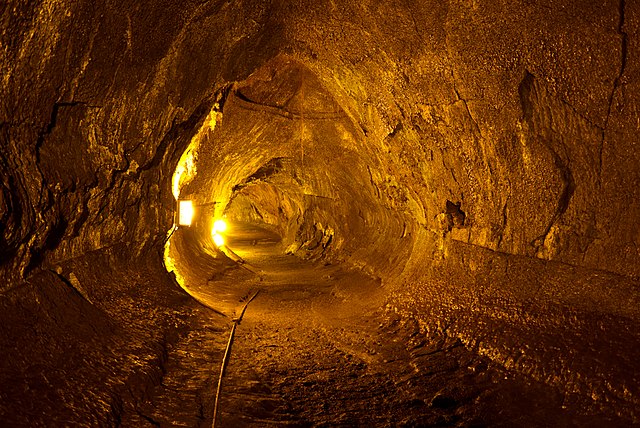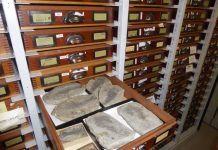
By Jim Brace-Thompson
Lava tubes form during the eruption of a basaltic lava flow. A hardened crust forms on the surface of the flow while, beneath that crust, fiery hot liquid lava continues to move in “lava streams.” These sometimes empty out, leaving long cave-like channels underground.
Such lava tubes are fun to explore—after things have cooled down, of course! For instance, not so very far from my own home are ancient lava tubes in the Mojave National Preserve. They offer a cool spot to rest after hiking in the hot desert sun, and they provide great photographic opportunities courtesy of natural skylights sending down shafts of light.
But Ancestral Puebloans apparently used lava tubes for more than fun adventure. Large amounts of ice built up in lava tubes in what is now El Malpais National Monument in New Mexico. Some of that ice is fairly old, and that’s what attracted University of South Florida paleoclimatologist Bogdan Onac. He and his team were in search of whatever ancient climate data the ice might hold. Find that, they did — along with an intriguing tale of human ingenuity and survival.
As they removed ice cores, they noticed charcoal embedded at different points. Charcoal gave them the perfect instrument to use radiocarbon dating. It turns out that the ages of charcoal-bearing layers in their core sample coincide with dates suggested by tree rings of major drought events between A.D. 150 and A.D. 950. It is speculated that Ancestral Puebloans were entering the lava tubes with fire to melt ice for life-sustaining water at times of drought in a hot, dry, and unforgiving environment.
Author: Jim Brace-Thompson
 Jim began and oversees the AFMS Badge Program for kids, has been inducted into the National Rockhound & Lapidary Hall of Fame within their Education Category, and is the president-elect for the American Federation of Mineralogical Societies.
Jim began and oversees the AFMS Badge Program for kids, has been inducted into the National Rockhound & Lapidary Hall of Fame within their Education Category, and is the president-elect for the American Federation of Mineralogical Societies.
Contact him at jbraceth@roadrunner.com.
If you enjoyed what you’ve read here we invite you to consider signing up for the FREE Rock & Gem weekly newsletter. Learn more>>>
In addition, we invite you to consider subscribing to Rock & Gem magazine. The cost for a one-year U.S. subscription (12 issues) is $29.95. Learn more >>>


 Hide i
Hide i












